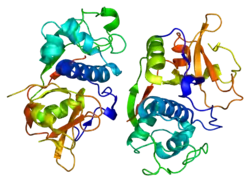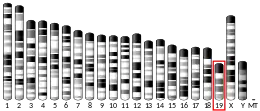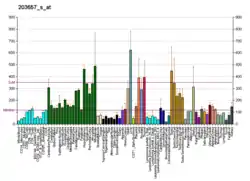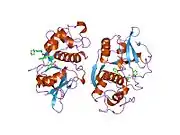| CTSF | |||||||||||||||||||||||||||||||||||||||||||||||||||
|---|---|---|---|---|---|---|---|---|---|---|---|---|---|---|---|---|---|---|---|---|---|---|---|---|---|---|---|---|---|---|---|---|---|---|---|---|---|---|---|---|---|---|---|---|---|---|---|---|---|---|---|
 | |||||||||||||||||||||||||||||||||||||||||||||||||||
| |||||||||||||||||||||||||||||||||||||||||||||||||||
| Identifiers | |||||||||||||||||||||||||||||||||||||||||||||||||||
| Aliases | CTSF, CATSF, CLN13, cathepsin F | ||||||||||||||||||||||||||||||||||||||||||||||||||
| External IDs | OMIM: 603539 MGI: 1861434 HomoloGene: 31194 GeneCards: CTSF | ||||||||||||||||||||||||||||||||||||||||||||||||||
| |||||||||||||||||||||||||||||||||||||||||||||||||||
| |||||||||||||||||||||||||||||||||||||||||||||||||||
| |||||||||||||||||||||||||||||||||||||||||||||||||||
| |||||||||||||||||||||||||||||||||||||||||||||||||||
| |||||||||||||||||||||||||||||||||||||||||||||||||||
| Wikidata | |||||||||||||||||||||||||||||||||||||||||||||||||||
| |||||||||||||||||||||||||||||||||||||||||||||||||||
Cathepsin F is a protein that in humans is encoded by the CTSF gene.[5][6][7]
Cysteine cathepsins are a family of cysteine proteases that represent a major component of the lysosomal proteolytic system. In general, cathepsins contain a signal peptide, followed by a propeptide and then a catalytically active mature region. The very long (251-amino acid residues) proregion of the cathepsin F precursor contains a C-terminal domain similar to the pro-segment of Cathepsin L-like enzymes, a 50-residue flexible linker peptide, and an N-terminal domain predicted to adopt a cystatin-like fold. The cathepsin F proregion is unique within the papain family cysteine proteases in that it contains this additional N-terminal segment predicted to share structural similarities with cysteine protease inhibitors of the cystatin superfamily. This cystatin-like domain contains some of the elements known to be important for inhibitory activity. CTSF encodes a predicted protein of 484 amino acids that contains a 19-residue signal peptide. Cathepsin F contains five potential N-glycosylation sites, and it may be targeted to the endosomal/lysosomal compartment via the mannose 6-phosphate receptor pathway. The cathepsin F gene is ubiquitously expressed, and it maps to chromosome 11q13, close to the gene encoding cathepsin W.[7]
In non-human species
Immunodiagnosis of Opisthorchis viverrini
Opisthorchis viverrini, a parasite, is typically detected by stool examination, specifically by counting eggs. However, this non-invasive, "gold standard" method can be unreliable in light infection and labor-intensive. An ELISA assay that detects the presense of the parasite's cathepsin F protein may be used as an alternative way to test for the parasite's presence.[8]
Discovery in Yesso scallop (Mizuhopecten yessoensis)
The Yesso scallop (Mizuhopecten yessoensis), was found in 2018 to express Cathepsin F in response to bacterial infection. The Yesso scallop has been suffering from high mortality due to bacterial diseases. Understanding the workings of its innate immune system, in various embryonic developmental stages, may help the associated aquaculture industry.[9]
References
- 1 2 3 GRCh38: Ensembl release 89: ENSG00000174080 - Ensembl, May 2017
- 1 2 3 GRCm38: Ensembl release 89: ENSMUSG00000083282 - Ensembl, May 2017
- ↑ "Human PubMed Reference:". National Center for Biotechnology Information, U.S. National Library of Medicine.
- ↑ "Mouse PubMed Reference:". National Center for Biotechnology Information, U.S. National Library of Medicine.
- ↑ Wang B, Shi GP, Yao PM, Li Z, Chapman HA, Bromme D (Dec 1998). "Human cathepsin F. Molecular cloning, functional expression, tissue localization, and enzymatic characterization". J Biol Chem. 273 (48): 32000–8. doi:10.1074/jbc.273.48.32000. PMID 9822672.
- ↑ Santamaria I, Velasco G, Pendas AM, Paz A, Lopez-Otin C (Jun 1999). "Molecular cloning and structural and functional characterization of human cathepsin F, a new cysteine proteinase of the papain family with a long propeptide domain". J Biol Chem. 274 (20): 13800–9. doi:10.1074/jbc.274.20.13800. PMID 10318784.
- 1 2 "Entrez Gene: CTSF cathepsin F".
- ↑ Teimoori, Salma; Arimatsu, Yuji; Laha, Thewarach; Kaewkes, Sasithorn; Sereerak, Piya; Tangkawattana, Sirikachorn; Brindley, Paul J; Sripa, Banchob (December 2015). "Immunodiagnosis of opisthorchiasis using parasite cathepsin F". Parasitology Research. 114 (12): 4571–4578. doi:10.1007/s00436-015-4703-9. ISSN 0932-0113. PMC 4917378. PMID 26344868.
- ↑ Guo, Haobing; Li, Yangping; Zhang, Meiwei; Li, Ruojiao; Li, Wanru; Lou, Jiarun; Bao, Zhenmin; Wang, Yangfan (September 2018). "Expression of Cathepsin F in response to bacterial challenges in Yesso scallop Patinopecten yessoensis". Fish & Shellfish Immunology. 80: 141–147. doi:10.1016/j.fsi.2018.06.005. PMID 29879509. S2CID 47014597.
Further reading
- Nägler DK, Sulea T, Ménard R (1999). "Full-length cDNA of human cathepsin F predicts the presence of a cystatin domain at the N-terminus of the cysteine protease zymogen". Biochem. Biophys. Res. Commun. 257 (2): 313–8. doi:10.1006/bbrc.1999.0461. PMID 10198209.
- Wex T, Levy B, Wex H, Brömme D (1999). "Human cathepsins F and W: A new subgroup of cathepsins". Biochem. Biophys. Res. Commun. 259 (2): 401–7. doi:10.1006/bbrc.1999.0700. PMID 10362521.
- Wex T, Wex H, Brömme D (2000). "The human cathepsin F gene--a fusion product between an ancestral cathepsin and cystatin gene". Biol. Chem. 380 (12): 1439–42. doi:10.1515/BC.1999.185. PMID 10661872. S2CID 28469574.
- Shi GP, Bryant RA, Riese R, et al. (2000). "Role for cathepsin F in invariant chain processing and major histocompatibility complex class II peptide loading by macrophages". J. Exp. Med. 191 (7): 1177–86. doi:10.1084/jem.191.7.1177. PMC 2193169. PMID 10748235.
- Deussing J, Tisljar K, Papazoglou A, Peters C (2000). "Mouse cathepsin F: cDNA cloning, genomic organization and chromosomal assignment of the gene". Gene. 251 (2): 165–73. doi:10.1016/S0378-1119(00)00196-7. PMID 10876093.
- Strausberg RL, Feingold EA, Grouse LH, et al. (2003). "Generation and initial analysis of more than 15,000 full-length human and mouse cDNA sequences". Proc. Natl. Acad. Sci. U.S.A. 99 (26): 16899–903. Bibcode:2002PNAS...9916899M. doi:10.1073/pnas.242603899. PMC 139241. PMID 12477932.
- Oörni K, Sneck M, Brömme D, et al. (2004). "Cysteine protease cathepsin F is expressed in human atherosclerotic lesions, is secreted by cultured macrophages, and modifies low density lipoprotein particles in vitro". J. Biol. Chem. 279 (33): 34776–84. doi:10.1074/jbc.M310814200. PMID 15184381.
- Gerhard DS, Wagner L, Feingold EA, et al. (2004). "The status, quality, and expansion of the NIH full-length cDNA project: the Mammalian Gene Collection (MGC)". Genome Res. 14 (10B): 2121–7. doi:10.1101/gr.2596504. PMC 528928. PMID 15489334.
- Vazquez-Ortiz G, Pina-Sanchez P, Vazquez K, et al. (2006). "Overexpression of cathepsin F, matrix metalloproteinases 11 and 12 in cervical cancer". BMC Cancer. 5 (1): 68. doi:10.1186/1471-2407-5-68. PMC 1175083. PMID 15989693.
- Kaakinen R, Lindstedt KA, Sneck M, et al. (2007). "Angiotensin II increases expression and secretion of cathepsin F in cultured human monocyte-derived macrophages: an angiotensin II type 2 receptor-mediated effect". Atherosclerosis. 192 (2): 323–7. doi:10.1016/j.atherosclerosis.2006.08.001. PMID 16963053.
External links





